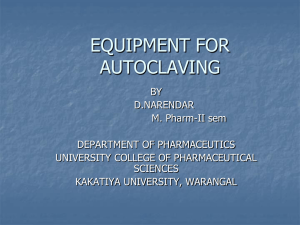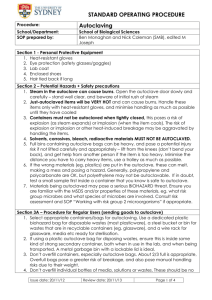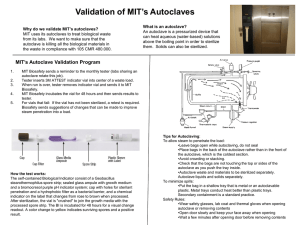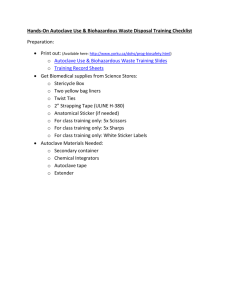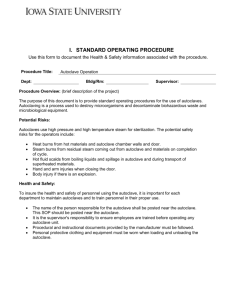Operation of Autoclaves
advertisement
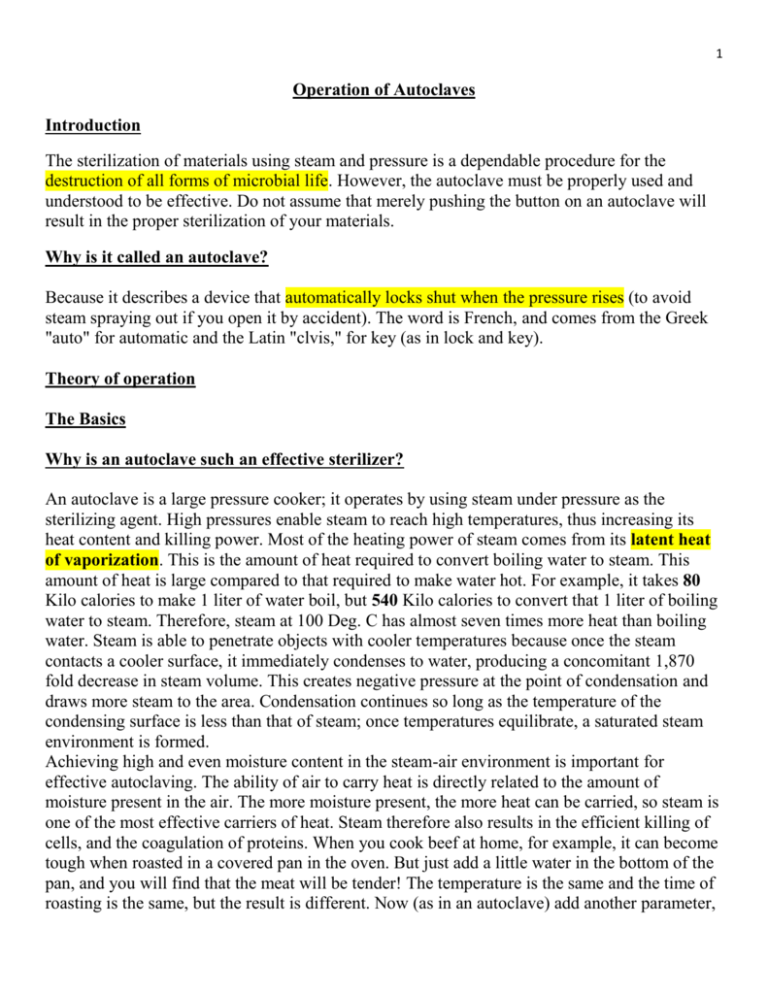
1 Operation of Autoclaves Introduction The sterilization of materials using steam and pressure is a dependable procedure for the destruction of all forms of microbial life. However, the autoclave must be properly used and understood to be effective. Do not assume that merely pushing the button on an autoclave will result in the proper sterilization of your materials. Why is it called an autoclave? Because it describes a device that automatically locks shut when the pressure rises (to avoid steam spraying out if you open it by accident). The word is French, and comes from the Greek "auto" for automatic and the Latin "clvis," for key (as in lock and key). Theory of operation The Basics Why is an autoclave such an effective sterilizer? An autoclave is a large pressure cooker; it operates by using steam under pressure as the sterilizing agent. High pressures enable steam to reach high temperatures, thus increasing its heat content and killing power. Most of the heating power of steam comes from its latent heat of vaporization. This is the amount of heat required to convert boiling water to steam. This amount of heat is large compared to that required to make water hot. For example, it takes 80 Kilo calories to make 1 liter of water boil, but 540 Kilo calories to convert that 1 liter of boiling water to steam. Therefore, steam at 100 Deg. C has almost seven times more heat than boiling water. Steam is able to penetrate objects with cooler temperatures because once the steam contacts a cooler surface, it immediately condenses to water, producing a concomitant 1,870 fold decrease in steam volume. This creates negative pressure at the point of condensation and draws more steam to the area. Condensation continues so long as the temperature of the condensing surface is less than that of steam; once temperatures equilibrate, a saturated steam environment is formed. Achieving high and even moisture content in the steam-air environment is important for effective autoclaving. The ability of air to carry heat is directly related to the amount of moisture present in the air. The more moisture present, the more heat can be carried, so steam is one of the most effective carriers of heat. Steam therefore also results in the efficient killing of cells, and the coagulation of proteins. When you cook beef at home, for example, it can become tough when roasted in a covered pan in the oven. But just add a little water in the bottom of the pan, and you will find that the meat will be tender! The temperature is the same and the time of roasting is the same, but the result is different. Now (as in an autoclave) add another parameter, 2 pressure. By putting this same roast in a pressure cooker you can reduce the time it takes to cook this roast by at least three quarters, and you still get just as tender a finished product. How does killing occur? Moist heat is thought to kill microorganisms by causing coagulation of essential proteins. Another way to explain this is that when heat is used as a sterilizing agent, the vibratory motion of every molecule of a microorganism is increased to levels that induce the cleavage of intermolecular hydrogen bonds between proteins. Death is therefore caused by an accumulation of irreversible damage to all metabolic functions of the organism. Death rate is directly proportional to the concentration of microorganisms at any given time. The time required to kill a known population of microorganisms in a specific suspension at a particular temperature is referred to as thermal death time (TDT). All autoclaves operate on a time/temperature relationship; increasing the temperature decreases TDT, and lowering the temperature increases TDT. What is the standard temperature and pressure of an autoclave? Processes conducted at high temperatures for short time periods are preferred over lower temperatures for longer times. Some standard temperatures/pressures employed are: 115 Deg C at 10 psi 121Deg C at 15 psi 132 Deg C at 27 psi Psi = Pressure unit standing for pounds per square inch Please note that after loading and starting the autoclave, the processing time is measured after the autoclave reaches normal operating conditions of for example 121Deg C and 15 psi pressure, NOT simply from the time you push the "on" button. 3 How does the autoclave itself work? The diagram of an autoclave depicts the simplicity of its operation. Basically, steam enters the chamber jacket, passes through an operating valve and enters the rear of the chamber behind a baffle plate. It flows forward and down through the chamber and the load, exiting at the front bottom. A pressure regulator maintains jacket and chamber pressure at a minimum of 15 psi, the pressure required for steam to reach 121 Deg C. Overpressure protection is provided by a safety valve. The conditions inside are thermostatically controlled so that heat (more steam) is applied until 121C is achieved, at which time the timer starts, and the temperature is maintained for the selected time. 4 How to achieve perfect sterilization every time. By understanding the operation of the autoclave and other issues associated with your sample, you will be successful every time. Time/ Volume/ Mass/ Insulation/ Microbe concentration You must think about all of these variables! There is no simple formula for how long a certain item needs to be autoclaved to achieve sterility. Consideration must be given to the type of primary container (the beaker or flask or packet containing the item to be sterilized), the volume of liquid, amount of solid material, and the secondary container (such as a tray containing the primary container). Some examples of the considerations needed are described in the following sections. Time is critical As the cycle time will vary with the composition of the load, it is important to determine the appropriate time requirement. Some people assume that a time of 30 minutes is sufficient; however this often proves to be a very costly mistake. Secondary Containers Plastic or steel containers (trays) are commonly used to contain material during autoclaving, since it is important to contain spills. But don’t forget that such containers alter the nature of the autoclave run! Polypropylene plastic pans with 6 inch sides are favored over polyethylene and polystyrene because it can withstand autoclaving without melting. (Don’t ever autoclave a plastic item -- like a tray-- if you are not sure it can handle the heat. It is no fun to pry out a melted tray!). However, the use of a plastic container increases the time needed for autoclaving, since plastic is a good insulator. Always add 5 minutes when using a plastic tray. On the other hand, stainless steel containers are not only durable; they are a better conductor of heat so the run time will be a little faster. Do not use overly deep containers (greater than 6 inches), which may prevent displacement of air from the bottom. Also, ensure that steam can flow around the secondary container. Volume Obviously, the higher the volume, the more time is needed for sterilization (see general guidelines below). Generally, the volume of liquid per container is a more important consideration than the total volume. A 2-liter flask containing 1-liter of liquid takes longer to sterilize than four 500 mL flasks each containing 250-mL of liquid! 5 Indicators These are tools used to validate the autoclaving process. However, use this with caution. Stickon tape indicators can only be used to verify that the autoclave has reached normal operating temperatures for decontamination but not that the run was long enough. Biological indicators can be used in the efficacy testing of the autoclave process to effectively sterilize the contents being treated. JUST TO BE SAFE When running the autoclave make sure that it reaches the desired pressure and temperature. Also, before using the autoclave, check the drain screen at the bottom of the chamber and clean if blocked. If the sieve is blocked with debris, a layer of air may form at the bottom of the autoclave, preventing efficient operation. Microbial load Contaminated items take longer to sterilize than clean items. Consequently, water sterilizes faster than yeast-extract containing media (which contains lots of microbes), or media left at room temperature for a while before autoclaving (which allows the concentration of microbes to increase). Also, some types of microbes are more resistant to autoclaving than others. Be cautious of packages wrapped too tightly. Air and steam do not mix readily. Air, being heavier than steam, normally is displaced to the bottom of the sterilizer and is then forced out through the drain. If your dry items are wrapped too tightly, however, air is trapped and cannot escape. It forms cool air pockets at the center of the packages, preventing the items from reaching temperatures sufficient to kill all microorganisms. If you have a large bag of dry items to sterilize, consider adding some water to the bag. This will create additional steam which will displace the dry air from the bag, increasing the rate of heat penetration. Can things be autoclaved too long? Yes. Nutrients in media, for example, often break down in the presence of heat. Consequently, a load of media filled containers should be of similar size, shape, content and volume, because exposure time is based on these characteristics. Otherwise some items might cook too long, and others too short. 6 Packing the autoclave As much attention must be applied to loading the autoclave as was given to packaging. Again, the determining factor is ensuring heat/steam penetration. Therefore care must be given to avoid overloading the chamber or placing bags in the chamber which are too large. You should also leave room between bags, bottles, etc. for steam circulation. If you must cram the autoclave very full (or fill a tray full with bottles, you probably have to increase the treatment time by 510 minutes. Some general guidelines. Here are some recommended times for autoclaving liquids of the following volume per container: 75 - 200 ml 200 - 500 ml 50 - 1000 ml 1000 - 1500 ml 1500 - 2000 ml 20 minutes 25 minutes 30 minutes 35 minutes 40 minutes Remember to modify these times as needed!!!!! For example, more time is required if the flasks in a plastic tray (which is the standard method); if many bottles are close to each other in the tray; if the chamber is full of several trays; if the liquid contains microbes; if you are using plastic instead of glass containers; etc. Therefore, you probably need to go longer than the times indicated above. Let’s talk about safety Due to the fact that autoclaves utilize steam, heat and pressure, the risk of personal exposure and potential harm is great. Personnel should wear proper personal protective equipment, i.e. heat resistant gloves, eye protection and a lab coat, particularly when unloading the autoclave. Regularly inspect the autoclave for proper operation. Do not assume that the temperature and pressure is down before opening the chamber (look at the gauges). Even if the pressure gauge shows "0", open the chamber carefully; crack the door to allow steam to dissipate (don’t fling the door open, as steam might come out and burn you). After opening the door, let items sit for five minutes before handling. This will reduce the chance of boil-overs and burns. Never place sealed containers in an autoclave, they might explode! This allows for expansion during the cycle. Caps must be slightly loose so that pressure created during the cycle does not cause the vessel to break. For screw-cap containers, you can make the lid hand tight and then loosen the lid by one-half turn. Always leave a few inches of "head room" in your containers. That way, if the item boils, it won’t spray out into your face. Liquids to be autoclaved must be in an autoclavable vessel that 7 is at least twice as large as the volume to be autoclaved (i.e. If you are autoclaving 1 liter of media, you need to put it in a flask that hold at least 2 liters). Always autoclave media in a pan, to contain spills. Agar will clog the drain in the autoclave and break it. Do not autoclave items containing solvents, volatile or corrosive chemicals (phenol, trichloroacetic acid, ether, chloroform, etc.) or any radioactive materials.



